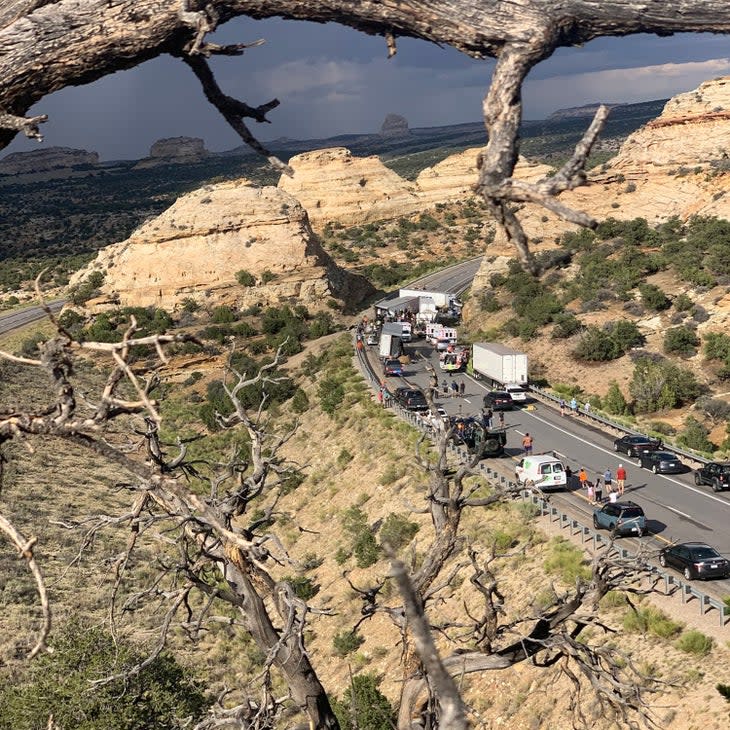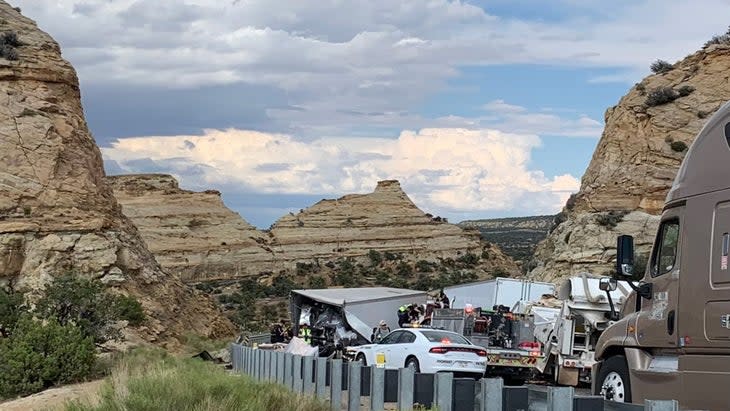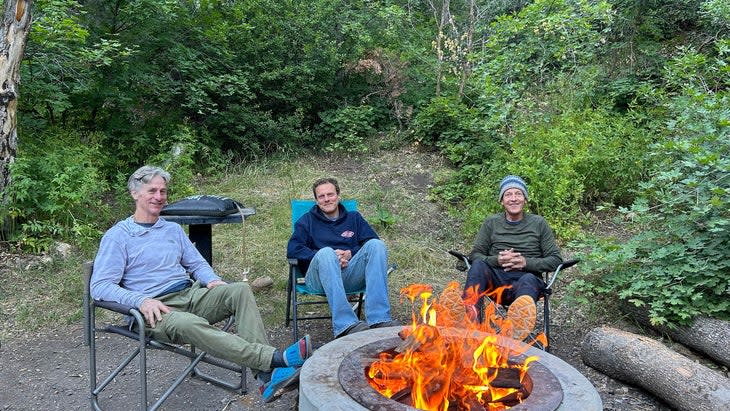The Stranger in the Storm
This article originally appeared on Outside
Mile marker 120, 4 p.m. on a Sunday. Three of us were heading home to Western Colorado after a great climbing and camping trip to Maple Canyon, the Uinta National Forest, Utah. The drive is about six hours, much of it on I-70 with posted speeds of 80. It's a beautiful, big-horizon route, cutting through the San Rafael Swell with its overlapping fins and upthrust white-rock formations named Ghost Rock or Temple Mountain.
We were on a straightaway 40 miles west of Green River, the halfway mark on the trip, when we drove into a curtain of rain just ahead of a blind curve. Through sudden splats on the windshield I spotted a man on the shoulder to our left, in front of a bluff wall. He was violently waving downward, over and over. He had a beard, a white T-shirt. No rain jacket.
"Slow way down," I said to my husband, Mike Benge, who was surely already starting to brake. "Way down."
We decelerated around the curve onto an eighth- or quarter-mile hill. In front of us were two lines of cars at a full stop on the highway, with ahead a chaos of flung vehicles.
All I could think of was my friend Laura Kirk's husband, Dave Carpenter, who came along on highway 70 in winter, slowed to a stop upon seeing an accident ahead, and had just said to a coworker, "I think we're going to be here awhile," when they were hit from behind and spun completely around. (They were somehow uninjured; the car was totaled.)
"Pull over to the shoulder," I urged, and we swerved off.
The rain was now hammering; cars behind us were also braking hard. We heard the first siren.
In probably five minutes the line of backed-up cars stretched up the hill and around the curve, so that the taillights would be visible from the highway behind. About 20 cars ahead of us was a four-semi pile up. Glass and metal pieces were strewn across the highway.
"We were probably three or four minutes behind it," our friend Jim Gilchrist said from the back seat. More sirens. The rain poured in thick gushers over the nearby banks, outward onto the road. When the torrents eased, I left the truck, tried to ask around for information. A helicopter arrived, circled, landed.

We saw rescue vehicles arrive, the Jaws of Life carried down the hill: one set, and behind it another. Somehow, only one person was injured, but he would have to be cut out from his truck.
The truck had carried too much speed down the greasy hill and skidded; the truck behind him couldn't stop in time; a third one managed to pull over but was hit by the fourth, which ripped the third in massive glancing blows all down its side.
We were to wait there for five hours. By providence no cars or citizen pickups (like the one we were in) were in the mayhem. Grateful to have been those few minutes behind the pileup, and for a guy who thought fast, bolted up the hill, and stood out in the rain to warn others, I asked people who he was to try thank him. No one knew.
I think back and still picture him in a T shirt, though I may be wrong that it was white. In any rain, you get soaked and cold immediately. He saw the implications and acted. I'm certain he prevented other crashes, and I wonder if he saved lives. We’d have come around the bend at highway speeds to a string of stopped cars.
People milled around, walked their dogs. Mike, Jim, and I met others. "It's such a random group, thrown together for hours," Mike said. We shared food from our coolers, got some information from a doctor traveler who had walked down to the site to see if he could help; I urged his shy teenaged son to have more of our carrots and hummus.

Finally the helicopter flew away, the injured driver in it, all of us watching in silence. I only knew that the driver was in his 40s or so, not young and inexperienced, as many truckers seem to have been in recent semi accidents on I 70. There were six semi wrecks on highway 70 in my area, near Glenwood Springs, in January 2022 alone. The interstate is for many a line to recreation--hiking, skiing, rafting, climbing--but it is crowded and beset by heavy weather.
"He'll be there in 20 minutes," Mike said of the driver. I remembered that my old roommate, a critical-care nurse, always said the hospital in Grand Junction was excellent.
That was this time last year. Later I found from a friend at a hospital that the truck driver who was cut out of his vehicle (which was missing its whole front end when we eventually, slowly drove by) had many injuries but would live and be for the most part OK.

Mike and I and another two friends have just made the same trip, to Maple Canyon in July, my sixth or seventh time there over the years. A few times were with Mike (once camping with our then young boys), and others with various friends and their friends and everybody's dogs.
On the way home, as we two approached Green River, both thought we'd note the site; and then to our surprise found ourselves at the milestone rest stop having passed it. Blue skies, dry roads. But I was grateful all over again.
I am originally from Annapolis, Maryland, and was there in the early winter of 1982 when a Boeing 737-222, Air Florida Flight 90, took off out of Washington, D.C., in a snowstorm, barely lifted, and crashed into the 14th Street Bridge and the ice-covered Potomac River, breaking into pieces.
The fatality toll was 78, including four people in vehicles on the bridge and 74 from the plane. Five people--four passengers and a single crew member--from the flight survived, rescued from the river. Another person was in the water, but at least once when a rescue helicopter arrived, he passed the lifeline to others. When the chopper came back, he had gone under.
We in the region waited, appalled by the news and images, wondering who the man had been. For a time no one could say. But I remember that co workers of Arland Williams, age 46, believed it was he and that his actions aligned with what they knew of him. For a time there was even something mystical to observers in not knowing: a strange sense that we could attribute the best in human nature to anyone there.

Eventually Williams's body was retrieved, and identified as the only passenger who died of drowning.
I'd like to think the guy in the white T shirt could be any of us. I'm sure I'd be willing, but doubt I'd have thought that fast. Maybe now I would, and that, too, is thanks to him.
**********************************************************************************
Now and then the internet helps us solve a mystery, such as this one, when, ten years ago, a curious Aspen Times reporter, Tim Mutrie, unearthed an old climbing pack in an office closet and wondered where it came from. By chance I saw his note on Facebook. In 1988, four of us had found that lone pack, a disquieting sight, on top of the remote 400-foot Moses Tower, Taylor Canyon, Utah. Tim opened the old camera within and had the film developed. A week later we had a face, and in three weeks, again by chance, we had answers.
Maybe the internet can help here. If you think you know who the quick thinker was at this accident, please write aosius@outsideinc.com.
Alison Osius is a travel editor at Outside.
For exclusive access to all of our fitness, gear, adventure, and travel stories, plus discounts on trips, events, and gear, sign up for Outside+ today.

